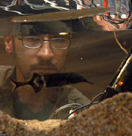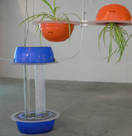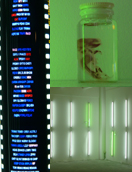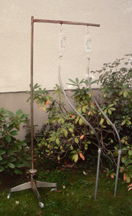 |
 |
 |
 |
 |
 |
|
A small group exhibition titled “Axis: Art – Science”
was presented in Berlin’s Backfabrik from September 3 to October
3, simultaneous with the larger Berlin Preview exhibition at the same
location. This exhibition was curated by Marcus Ahlers and Jennifer Hickey
and presented seven international artists who each engaged the theme “art-nature-science”
in a different way.
A
visually enticing installation integrating wood, metal, glass, water,
slide projections, light and interactive switches was exhibited by Felix
Hediger from Berlin. He integrated found materials into an aesthetic thought-provoking
whole. The apple contains specific symbolic significance and is presented
as both a real object and as a slide projection. The apple serves as a
focal point to encourage the consideration of our understanding of nature.
|
 |
|
Technical
circuits enable the ironic and humorous installation “To squeak
or not to Squeak” by American artist Galo Moncayo. A spare visual
aesthetic is deployed. Numerous wooden levers, reminiscent of tools as
well as abstracted bird heads, are presented in several rows. One is reminded
of the reconstructed birdforms of Vladimir Tatlin’s flying machine
“Letatlin” from 1930/32. The wooden levers each squeeze an
inflated plastic pillow, producing a squeaking sound. If and how often
a lever squeezes a pillow is decided by a neural network, the fundamental
concept of “artificial intelligence”. The effect of this abstracted
and technical presentation is baffling and makes one think of controlled
and uncontrolled communication, but not without being amused in the process. |
 |
|
Communication
is also the theme of Manchester artist Anthony Hall’s videoinstallation,
presented on a television monitor. The viewer can put on headphones and
hear the electrical signals -made audible by the speakers- given off by
the Long-Nose Elephant Fish (Gnathonemus Petersii) shown in the video.
This fish explores his surroundings by creating a field of electrical
current. This current is analyzed and transformed into an acoustic signal
through the use of electrodes hung in the aquarium. In this way, the artist
directs attention to the relevance of the fish’s electrical field
in the context of social communications. In another sense, the presentation
in video format raises questions regarding the role of media in social
communications among humans - lending the piece a vital layer of meaning.
|
 |
Tim
Deussen approaches the theme of human and technology from a completely different
perspective. His work engages the theme of the exhibition with an examination
of the historical situation of the holocaust in Auschwitz. The dizzying
and shocking reminder of the application of human intelligence and creativity
to the task of murder is newly evoked in his work “Die Kreativität
das Schlächters”. As part of the collage, the floor plan of one
of the creamatoriums at Auschwitz is displayed beside texts and photos from
Rudolf Höss involving suggestions for the technical improvement of
the facilities and procedures for the gruesome annihilation. This historical
context serves as a warning reminder of the human faculties associated with
new inventions and the questionable potential of the human spirit.
|
 |
| Marcus
Ahlers (Berlin/USA) constructs a formally aesthetic hanging sculpture from
three construction helmets that each has a plant growing in them and works
with saltwater under the title “Electrolysis Project”. He splits
the saltwater molecules apart with the help of 12 volts electricity, producing
Chloride and Hydrogen gasses. The gasses emerge from the central unit of
the installation and seem to disappear into two separate plastic sacks.
The results of electrolysis experiments shows the separation of a substance
into new components, which are here presented in an artistic form. In this
case, these results are intended to function in a metaphorical manner, encouraging
a contemplation
of substance, existense and perception. |
 |
| Sebastian
Walter is a Berlin native and works with biological materials. For this
exhibition he displays the decoding of the human genome in the form of photo-negatives
attached to florescent tubes hanging vertically on the wall. The number
of tubes is 24, respective of the number of chromosomes in the genome. Four
of the tubes glow green and thereby point to the existense of the ̶
0;Hox-genes”
depicted on the photonegative strip. These Hox-genes are responsible for
assuring
the proper physical form during the development of a living being.
The biological manner in which the form of a living organism is predetermined
is addressed in the installation through the different colored florescent
tubes. In this way, the formal qualities of nature are confronted with the
formal qualities of artistic creation. Glass vials containing plant and
animal specimens and headphones offering an audible listing of the letters
of the coded sequence complete this installation titled “Consensus”. |
 |
| The
works of Nicolas Kerksieck form the beginning as well as the end of the
exhibition. An organic bladder-form of latex and plaster lies on the floor
and is attached to plastic tubing. The preformed nature and synthetic materials
of the fabricated bladder underscores the contrast to the human bladder
and the ambivalence between the two. Photographs hung on the wall contribute
to the conceptual context of the work. This belly-like form, according to
the artist “Kmut”, is thereby in one photograph attached to
the exhaust pipe of a car, and in another to the drainage pipe of a sink.
Through these connections, the work is coupled with “life” and
stripped of aesthetic and thought-provoking energy. The other exhibited
works also seem to deal with the notion of duality: one photograph,
titled
“Lokale Heilung” (Local Healing), show a garden landscape with
two empty medical infusion bags hung from one rack, extended with the customary
plastic tubing and terminating at two metal pipes. The metal pipes are thrust
into the lawn. In an inversion of the norm, here it is nature that is medically
treated rather than the human. In this context the relationship between
nature and technology is examined in an ironic and critical fashion. The
instrument itself stands in the room as a sculptural object. |
 |
|
text
by Verena Schermer, art historian (MA)
translated by Marcus Ahlers |
|
|